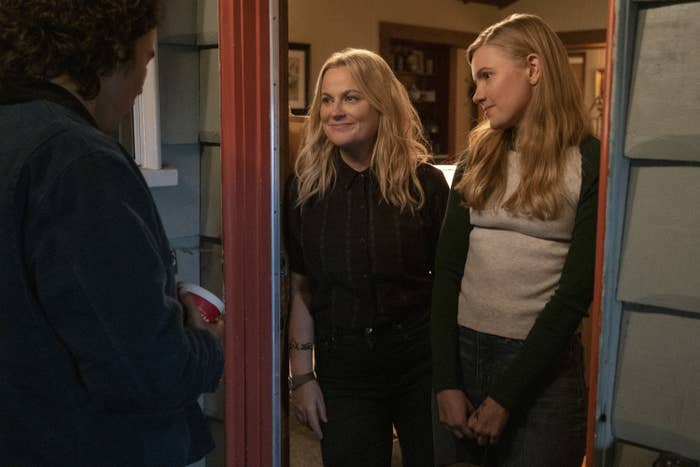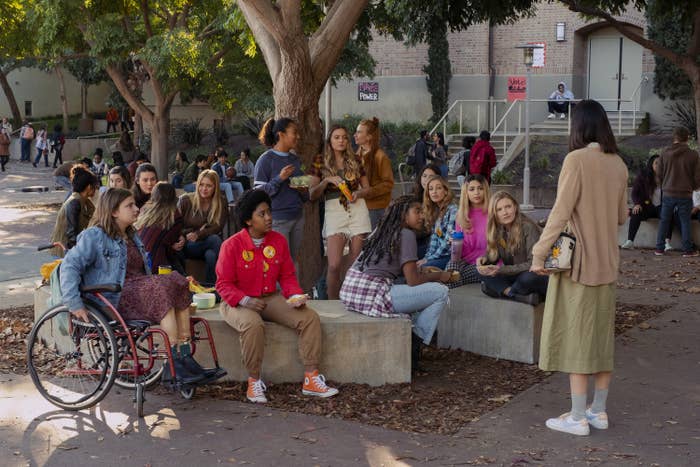
When I first saw the trailer for the new Netflix comedy Moxie, out on March 3, I felt like the movie had been made for me, specifically. There was talk of revolution, smashing the patriarchy, and teen girl rebellion, all set to the very good “Rebel Girl” by Bikini Kill. I was all in.
Moxie stars Hadley Robinson as Vivian, a 16-year-old who discovers feminism through the mementos of her mother, Lisa (Amy Poehler, who also directed the film), who was in the riot grrrl scene as a young woman. After the boys at Vivian’s school make a list ranking the girls and their so-called fuckability, Vivian makes a zine, called Moxie, to spread the gospel of gender equality. She befriends a cool new girl, the already politically minded Lucy (Alycia Pascual-Peña). Lucy brings Vivian further into the feminist fold, and together they help take down their principal, who doesn’t seem to care about the list, the rampant sexism at the school, or Mitchell, the school’s douchebag quarterback. It’s a classic coming-of-age tale, but with a feminist bent and a nostalgic girl-punk soundtrack.
This was, in part, very familiar to me. At 16, I learned about riot grrrl feminism through a cool friend on LiveJournal, and went down my own journey of devouring feminist literature and dancing around my room to Bikini Kill. I became that person in the hallways of my high school ranting about rape culture and beauty standards during lunch hour. I was very, very earnest. But it was an awakening. I suddenly had the words and cultural context to understand the rage I was carrying around about my peers, media representations of women, and the guy who was always trying to brush my boobs with his arm.
I didn’t secretly distribute a zine in the girls’ washroom, but I did have something else in common with Vivian: I fell into the complacency of white feminism. My burgeoning politics were pretty basic and informed by what I now know was a narrow perspective. I could recite facts about the wage gap, but didn’t know how much worse it was for women of color. I complained about the standards for women’s bodies, but didn’t know they were rooted in anti-Blackness. I helped found my school’s gay–straight alliance, but even as a little closeted queer, I knew nothing about the language of liberation.
I was still learning, and growing pains can be, well, painful. Moxie puts that tricky evolution on display, with Vivian stumbling over how best to express her rage, figuring out how to target it at the right people, and trying to navigate a rather cute romance with the very sweet, feminist-minded Seth (Nico Hiraga). And like me, Moxie is admirably earnest — nowhere more so than with its often ham-fisted dance around more complex elements of feminism and inclusion.

Early on, when quizzed about her activist past, Lisa tells her daughter that her youthful rebellions were riddled with mistakes, including a lack of intersectionality in her activism. In part, this is a setup to give Vivian an opportunity to correct that mistake, but it's a setup for the film to struggle as well.
Although Vivian is hailed as a hero for her creation of the Moxie zine, it’s her new friend Lucy who feels like the real heart of the story. Lucy is Afro-Latina and has a strong voice she’s willing to use to talk back to Mitchell, making a harassment complaint and refusing to accept any boys-will-be-boys excuses. As the new girl, Lucy is targeted by Mitchell, and while she has the guts to talk back to him, the film never explores how her race also makes her particularly vulnerable, given that Black girls are more likely to experience sexual harassment at school.
With Lucy and other students, Moxie replicates a much-criticized trope of Black characters being included mostly in order to help white characters learn something about themselves and the world. Two of Vivian’s friends, soccer players Amaya and Kiera (Anjelika Washington and Kiera Pascal), are Black, and already savvy about their own oppression, which influences Vivian’s blossoming feminism. This explanatory role extends to other BIPOC characters in the film, like Vivian’s best friend Claudia (Lauren Tsai). Take the moment when Claudia tells Vivian that, as the daughter of a Chinese immigrant, she feels less able to rebel openly, like Vivian does. The observation rings true, but then we never revisit it. Did Vivian actually learn anything?
This happens a lot. A minor character will say something that’s interesting or insightful, but we quickly move on to the next thing, making it feel like lip service. For example, CJ (played by Josie Totah, who is trans) talks about her name not being respected at school, but that’s the most we hear about her experience as a trans high schooler. There’s also a very quick sapphic kiss — blink and you’ll miss it.
It all made me wonder why Lucy, who was miles more compelling than Vivian, couldn’t be the protagonist. Why does the bumbling white girl get to lead the way?
I think I was hoping for some fabulous combination of Itty Bitty Titty Committee (which is also heavy-handed but has a huge heart) and Booksmart (which hilariously captures the spirit of Gen Z girls). But while Moxie succeeds at showing the power of girls working together, it doesn’t have the wit, bite, and fun of its recent peers.
But look, it’s not all bad. It was refreshing to see third-wave feminism front and center in a Netflix teen tale, rather than the usual pinkwashing, “girl boss” brand that’s still so popular. (The latter is even called out when the principal suggests a Lean In–style attitude to Vivian, much to her disappointment.) If Moxie inspires Gen Z girls to start making zines and listening to Sleater-Kinney, I’d call it a win.
Just like my young, oblivious self once learned, it takes time to get things right, or at least better. Moxie scratched some of the feminist-awakening itch the trailer promised, and there were moments of delight in watching girls get shit done. I just wish it hadn’t been such a pain getting there.●
